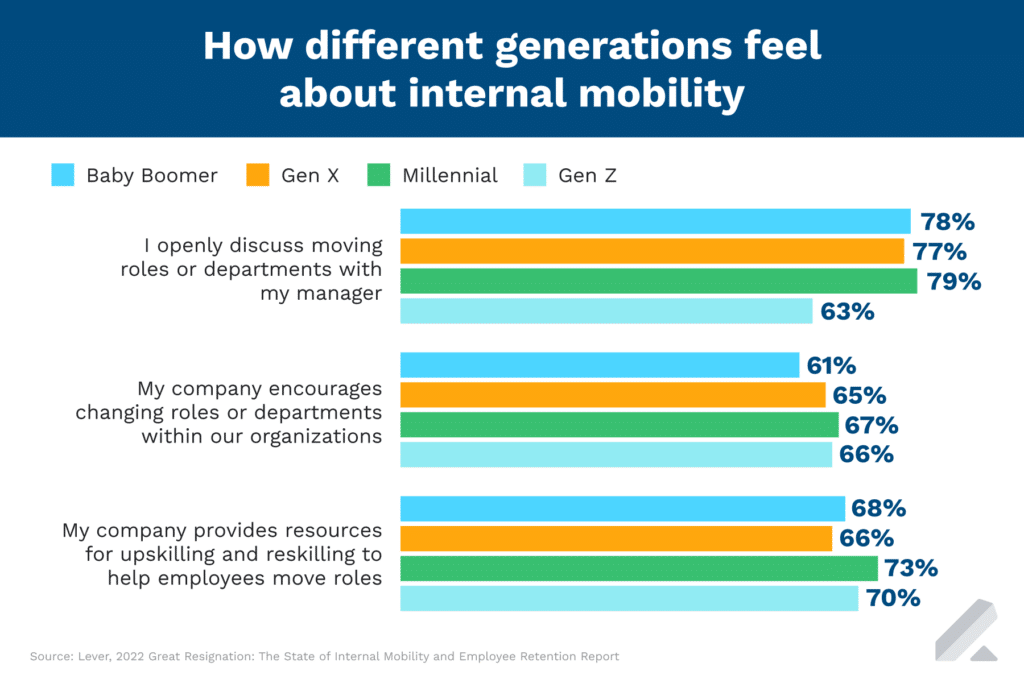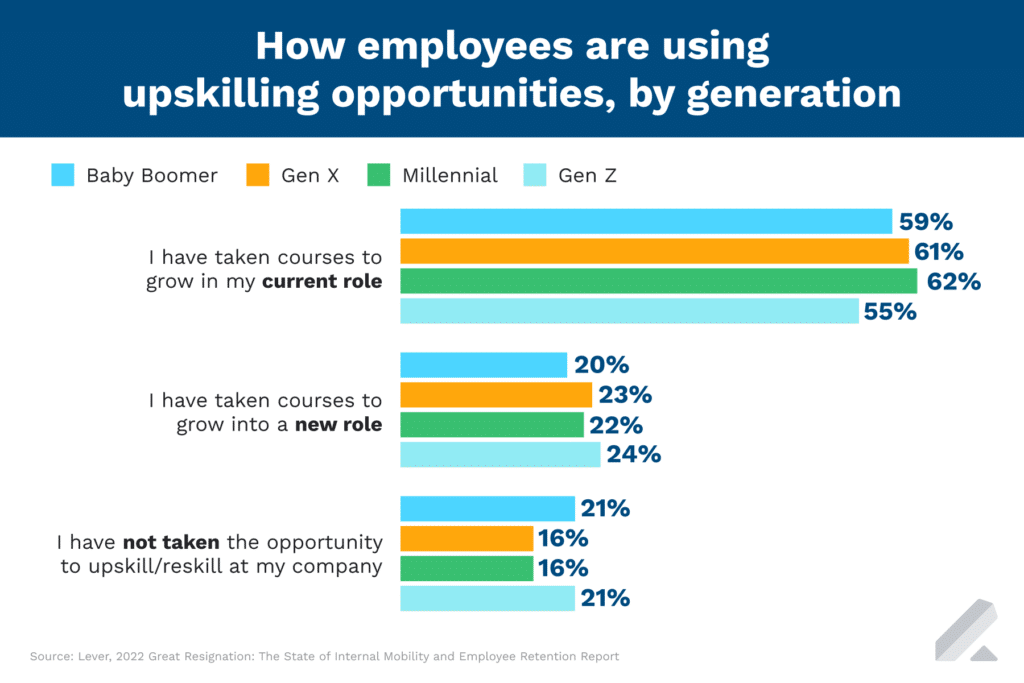You may have seen the memes and read the statistics: many employees are quitting their jobs, and “Why should we hire you?” is quickly turning into “Why should I work for you?”
Business leaders started talking about the Great Resignation in late 2021 when a record high of 4.5 million people quit their jobs in the US. More recent data shows this trend has continued into 2022, while other regions, like EMEA and APAC, have also been affected.
As HR professionals try to source and retain the best talent under these challenging circumstances, they must look for new ways to improve both the candidate and employee experience and boost employee retention. One of the best ways to achieve this is by investing in internal mobility.
Read on to learn more about what internal mobility is, why it’s important, and what you can do to improve the way it works at your company.
What is internal mobility?
Internal mobility refers to employees changing roles within an organization.
Rather than bringing in a new candidate from outside, recruiters may choose to fill an open position with an internal candidate. This allows the business to retain that employee’s knowledge and expertise while redeploying it in a different capacity.
It’s becoming increasingly more common for recruiters to hire for future internal mobility by looking for career agility in candidates — the ability of an employee to adapt to changing business needs and landscapes.
The most common type of internal mobility is a promotion — also known as a vertical move. When an employee is promoted, they move to a higher level of the company hierarchy based on performance or seniority.
However, promotions aren’t the only type of internal mobility. There may also be occasions when an employee wants to make a lateral move to another team or department.
For example, perhaps they’re developing a new skill set and want to move into a different type of position. Or maybe they want to move to a new city or country, and seek an internal transfer to a different office.
Why is internal mobility important? (4 key benefits)
Internal mobility offers several key benefits to both employees and companies. Here are a few good reasons to focus on internal mobility:
1) Internal mobility improves employee retention
With the Great Resignation in full swing, organizations are becoming more concerned with employee retention. In part, this is because losing employees is expensive.
Data from Gartner shows that employee turnover due to a lack of future career opportunities costs an average-sized organization $49 million per year.
The cost of turnover includes all the processes that go into hiring and training a new employee: hours of recruiters’ time, job board fees and other recruitment expenses, training materials and supplies for new hires, and time lost during interviewing, training, and onboarding.
Gallup estimates that the cost of replacing a single employee can range from one-half to two times their annual salary.
Not only is turnover expensive, but it can also harm company culture and employee morale. If employees see their company becoming a “revolving door” with their peers constantly quitting, this reflects poorly on the working environment.
Fortunately, companies with strong internal mobility cultures enjoy higher levels of employee retention. People stay 41% longer at companies with high internal hiring compared to those with low internal mobility, and 81% of talent professionals agree that internal recruiting improves retention.
Meanwhile, Lever’s 2022 Great Resignation Report found that 29% of employees would consider returning to a former employer for better growth opportunities, making it doubly important to foster a culture of internal mobility.
2) Internal mobility improves employee engagement
The Society for Human Resource Management (SHRM) defines employee engagement as “the level of an employee’s commitment and connection to an organization.”
Employee engagement is tied in with multiple dimensions of business performance, including lower turnover and absenteeism, and higher productivity. And internal mobility is directly related to engagement — employees are happier and more committed when they feel their employer supports their career goals.
According to Deloitte, after implementing an internal mobility program, one organization saw a nearly 30% boost in employee engagement.
Given roughly 41% of employees will ask for a role change in 2022, consider how opportunities for upskilling, reskilling, growth can help move people internally and keep top talent from jumping ship.

3) Internal mobility saves time and money
Filling open positions with qualified internal candidates can save a lot of time — 63% of talent professionals say internal recruiting accelerates the hiring process. This is because internal candidates are already integrated into the company and familiar with its culture.
Internal mobility also saves money. Since employee turnover carries significant costs, promoting internally rather than losing employees to a competitor is a smart business move.
And because internal hiring and onboarding processes are often shorter, they also tend to be less expensive: in total, it can be up to six times more expensive to hire externally vs. internally.
4) Internal mobility may lead to better performance and results
Finally, internal candidates often perform better than external candidates. Employees that are already familiar with a business’ culture will have less of a learning curve in the first few months of their new role.
Companies also already have a good understanding of internal hires’ work styles and past performance, so managing them and guiding them to achieve their full potential will be easier.
These factors may explain why internal hires routinely outperform external ones, according to research highlighted in the Harvard Business Review. And most HR professionals say their experience reflects this: 69% believe internal recruiting accelerates new-hire productivity.
Common internal mobility challenges
Even though internal mobility has numerous benefits for both companies and employees, many businesses still struggle to make it a part of their culture
In fact, over half of respondents to a Deloitte survey believed it would be easier for employees in their organization to find a new job externally rather than internally.
The same Deloitte study also showed that 59% of respondents rated their organization “fair” or “inadequate” at enabling internal mobility.
Like other company culture initiatives, internal mobility can be challenging to implement. It’s one thing to commit to improving internal mobility, but it’s quite another to actually launch an effective program and measure its success.
Respondents to the Deloitte survey said their top internal mobility challenges are:
- A lack of processes to identify and move employees
- A lack of availability of qualified employees to fill existing openings
- A lack of information for employees on available roles
- Manager resistance to internal moves
In short, it’s hard to facilitate internal mobility without an organized strategy. Companies will need to ensure that their team leaders are incentivized to promote internal mobility.
They’ll also need to make sure that HR staff can identify promising candidates and employees know where to look for internal job openings.
Creating a lasting culture of internal mobility may mean investing in new technologies, training HR staff and managers, and promoting the idea of internal mobility within teams.
7 internal mobility best practices you should implement
Create clear internal mobility policies
When improving any aspect of your company culture, the first place to start is by looking at your current policies. It’s important to have consistent internal mobility policies and ensure these are clearly communicated.
Ask yourself:
- Are employees aware of their upskilling and internal mobility options and how they can pursue them?
- Are employees supported if they want to pursue an internal move?
- Are managers encouraged and incentivized to promote internal mobility and regularly discuss this option with their reports?
- Are HR staff empowered to pursue internal candidates, and do they understand which skills exist within the internal talent pool?

Bring internal mobility into every stage of the employee lifecycle
To create a culture of internal mobility, you’ll need to weave it into everything you do. You can encourage internal mobility at every stage of the employee lifecycle — recruitment, onboarding, performance management, succession planning, learning and development, and offboarding.
Implement 1:1 meetings
Are your managers regularly having 1:1 meetings with their employees? These meetings are a great opportunity to spot promising talent, so you’ll want to ensure managers are empowered to use that time effectively.
Ideally, 1:1 meetings should take place every week and should be run using an organized agenda. Managers can use this time to track their employees’ progress and ask about their needs. This is a great time to bring up internal mobility.
For example, if an employee is looking to be promoted, learn more about a new area of expertise, or relocate, managers can help them move forward to meet those goals.
Run development-focused performance reviews
Performance reviews are a crucial component of internal mobility. Effective performance reviews will help develop talent and ensure no one gets overlooked for promotion.
For best results, performance reviews should occur at consistent times and present a clear roadmap for professional growth by measuring relevant skills and competencies.
We recommend they involve self-assessments and 360° reviews — evaluations from multiple people, such as managers, direct reports, peers, and external parties.
It’s essential to ensure reviews are data-driven and that you train your people to avoid unconscious bias in performance reviews.
Bias has a very negative impact on company culture — employees who perceive it are nearly three times as likely to be disengaged, and over three times as likely to say they’re planning to leave their current job within the year, according to data published in Forbes.
Set up development frameworks for all teams
A development framework (or career progression framework) is a roadmap laying out the skills and competencies employees must develop to grow within a company. It’s an extremely important tool for internal mobility.
Development frameworks give employees a clear idea of how they can grow and what they need to do to achieve their goals. Companies may create one general framework or separate frameworks for each team.
The career progression framework should lay out all levels of the company hierarchy (including job titles) and define which competencies need to be met to achieve each level.
Some companies create separate career tracks for individual contributors vs. people managers. This allows employees to see a growth path for themselves within the company, even if they aren’t interested in managing people.
For example, a “Junior Designer” could progress to “Senior Designer” as they improve their skills.
Offer continuous training
Learning and development is another key component of an internal mobility strategy. After all, employees need to develop skills to earn a promotion or move to another position.
Managers should be responsible for coaching team members and helping them meet their growth goals. This includes directing employees to the appropriate learning resources. Your company may already have a library of learning materials or prefer to use third-party content.
Either way, ensure that learning content is effective, that employees have access to the right materials, and that you have a way of testing employee skills and measuring knowledge acquisition — which a people enablement platform with learning features can help you do
Implement these internal mobility best practices at your org — with the right tools
Internal mobility is crucial for business success and benefits employers and employees. Since your people want to develop their careers and you want to fill your positions with the best talent, this is a great way to create a win-win situation.
During times when hiring is challenging, it’s particularly important to pay attention to the internal talent pipeline.
But to succeed with internal mobility in the long term, you’ll need to make it a permanent part of your company culture. This means putting the right policies in place throughout the employee lifecycle and investing in the right tools.
To learn more, check out Lever’s complete guide to internal mobility for companies today.



